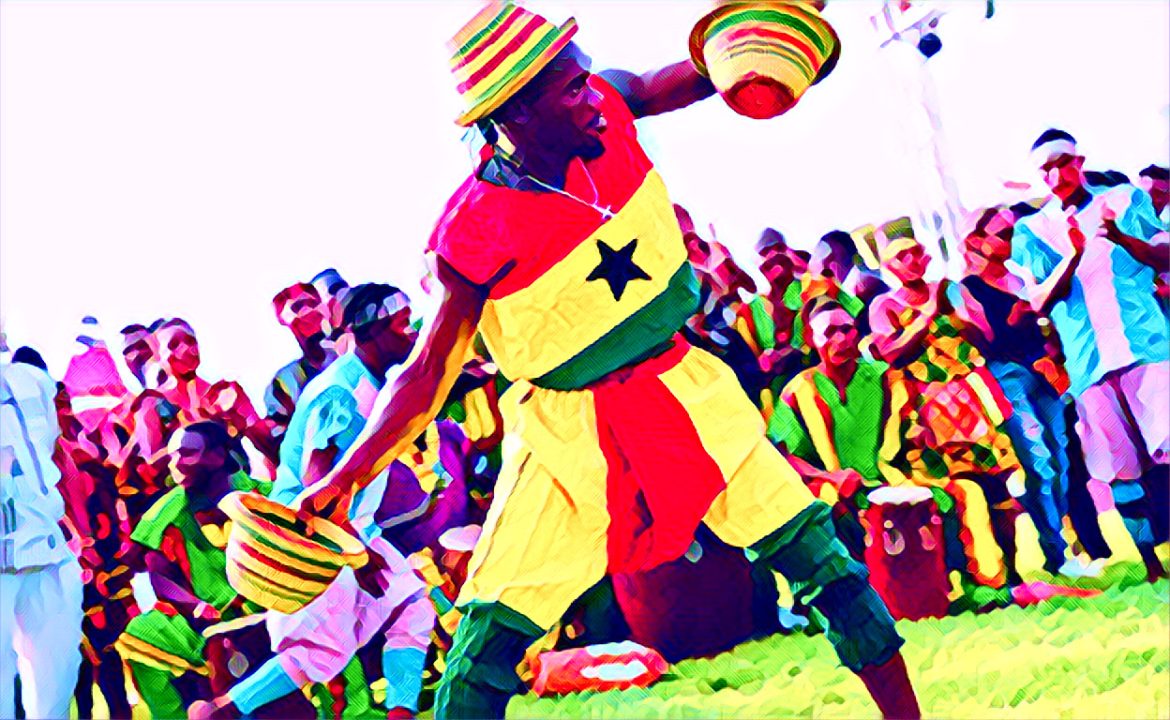KEY POINTS
- Tribal marks reflect the cultural identity and heritage of various ethnic groups in Ghana.
- Naming ceremonies are a joyous tradition celebrating the birth and identity of a child.
- Kente cloth weaving, once reserved for royalty, tells stories through its vibrant colors and patterns.
Ghana has a rich cultural environment influenced by many ethnic groups and is a nation steeped in tradition. Ghana’s cultural customs, which range from festivals to ceremonies, demonstrate a deep ties to the past and a persistent regard for legacy. These distinctive Ghanaian cultural customs showcase the nation’s rich and varied identity.
Tribal marks: A symbol of identity and heritage
Tribal marks are body or facial markings that have historically been used by a number of Ghanaian ethnic groups to identify their ethnic group or family.
They were previously a crucial component of identity and social standing, albeit being less prevalent now. Each mark is exclusive to a particular tribe, like the Ashanti or Ewe, and can signify anything from rites of passage to spiritual protection.
Despite its decline, the ritual is still a powerful representation of cultural history and community.
Naming ceremonies: A celebration of life
Naming rituals are important celebrations of a child’s birth in Ghana, especially among the Akan people. This custom, which is called “Outdooring,” often takes place eight days after the kid is born and involves naming and introducing them to the community.
Given that names are selected in accordance with ancestors’ names or the day of the week the kid was born, the naming process is infused with significance. The value of identity and community in Ghanaian society is beautifully reflected in this cultural ritual.
Kente cloth weaving: A royal tradition
One of Ghana’s most recognizable cultural icons is kente cloth. Kente, a vibrantly colored fabric weaved into elaborate designs that frequently carry messages or proverbs, was first worn by Ashanti kings.
As a symbol of pride and cultural identity, Kente weaving has been handed down through the centuries and is now worn during significant events like festivals and weddings. Since each hue and design has a distinct significance, Kente is more than simply a fabric—it’s a storytelling medium.
The Homowo festival: A celebration of harvest
For the Ga people of Ghana, Homowo, which translates to “hooting at hunger,” is one of the most important holidays. This event, which is celebrated every year, signifies the advent of a plentiful harvest and the end of a protracted time of hunger.
With drumming and dance filling the streets, participants partake in vibrant processions, communal feasts, and traditional rites. Moreover, Homowo demonstrates the Ga people’s tenacity and the significance of food security and community in their culture.
These cultural practices offer a glimpse into Ghana’s deep-rooted traditions, revealing the values and beliefs that continue to shape the country’s identity.





5 comments
Bonusangebote – die Quelle versiegt nicht gleich nach dem Willkommensangebot und auch bestehende Spieler können sich
über regelmäßige Angebote freuen Online Casino Boni, wie zum Beispiel Casinobonus Codes ohne Einzahlung sind keine Mittel, die Sie sich… Alle Bonusangebote werden von den Online Casinos nur einmal pro Person, Haushalt
oder IP-Adresse ausgegeben. Zumeist fällt der Zeitrahmen bei einem
Bonus ohne Einzahlung kleiner aus als bei einem Einzahlungsbonus.
Sie können diese Auflistung jederzeit benutzen, damit Sie das richtige Angebot für sich finden – oder
lesen Sie hier einfach weiter, um mehr Informationen über die
verschiedensten Marketingangebote oder Boni ohne Einzahlung zu
erfahren. Wir helfen und unterstützen Sie gerne dabei, die besten Bonusangebote und Bonuscodes ohne Einzahlung zu finden. Diese
Boni geben den Spielern die Möglichkeit, in einem Online Casino echtes Geld zu gewinnen, ohne eigenes Geld auszugeben oder
zu riskieren. Sollte das Spielen doch Probleme bereiten, gibt es unabhängige Hilfeangebote, die jederzeit erreichbar sind.
Der Restbetrag verfällt in diesem Falle und ist nur auf den maximalen Cash-out
eines Bonus beschränkt.📝 DurchspielanforderungenZu den Durchspielanforderungen eines Echtgeld
Casino Bonus ohne Einzahlung in Deutschland gehört ein Umsetzungsfaktor.
Manch ein Online Casino Bonus ohne Einzahlung 2025 in Deutschland führt noch klassische Gewinnspiele durch.
Bonus einlösenAGB gelten, 18+Super BonusInterwetten Bonus100% bis zu 100€Bonus einlösenAGB gelten, 18+VertrauenswürdigNovoline Bonus200 % Bonus
+ 10 Freispiele täglichBonus einlösenAGB gelten, 18+
References:
https://online-spielhallen.de/umfassender-ratgeber-zur-ice-casino-mobile-app/
Australian players who haven’t created an account yet are entitled to a welcome bonus.
Professional croupiers conduct real games where you interact with other players in real-time.
A welcome bonus represents incentive funds provided by
the casino to new players. Woo Casino stands as a reliable online gambling destination for Australian players
since 2020.
In addition to classic slot games, you can find progressive
jackpot and cryptocurrency pokies. The Curacao framework
provides Australian players with confidence that
Woo Casino operates under established rules and accountability mechanisms.
Live dealer games provide authentic casino atmosphere streamed directly to your screen. The collection emphasizes quality over quantity, featuring certified fair-play games from established developers.
No app download required—simply access the site through
your mobile browser and enjoy full functionality.
Table game fans find extensive collections of blackjack, roulette, baccarat, and poker variants.
Deposits reflect instantly across all methods, while
withdrawals process within 1-24 hours depending on your chosen option. This revolutionary system processes transactions in real-time, meaning
funds hit your account within minutes rather than days.
A 2023 study reported that GPT-4 obtained a better
score than 99% of humans on the Torrance Tests of Creative Thinking.
The company announced a slew of generative AI-powered features to counter OpenAI and Microsoft.
Their leaders emphasized their earlier caution regarding public deployment was due to the
trust the public places in Google Search. ChatGPT gained one million users in five days and 100
million in two months, becoming the fastest-growing internet application in history.
Kelsey Piper of Vox wrote that “ChatGPT is the general public’s first hands-on introduction to how powerful modern AI has gotten” and that
ChatGPT is “smart enough to be useful despite its flaws”.
As before, OpenAI has not disclosed technical
details such as the exact number of parameters or the composition of its training dataset.
It was capable of autonomously performing tasks through web browser interactions,
including filling forms, placing online orders, scheduling appointments, and
other browser-based tasks. These include, among many others, writing and debugging computer programs, composing music, scripts, fairy tales,
and essays, answering questions (sometimes at a level exceeding that of an average
human test-taker), and generating business concepts.
It is designed to generate human-like text
and can carry out a wide variety of tasks. ChatGPT’s training data includes software manual pages, information about internet phenomena such as bulletin board systems,
multiple programming languages, and the text of
Wikipedia.
The integration used ChatGPT to write prompts for DALL-E guided by conversations with users.
In October 2023, OpenAI’s image generation model DALL-E 3 was integrated into ChatGPT.
According to TechCrunch, it is a service based on o3
that combines advanced reasoning and web search capabilities to make comprehensive reports within 5 to 30 minutes.
At launch, OpenAI included more than 3 million GPTs created by GPT Builder users in the GPT Store.
References:
https://blackcoin.co/ggbet-casino/
us online casinos paypal
References:
worldwiderecruiters.ca
online blackjack paypal
References:
chefstronomy.co.za